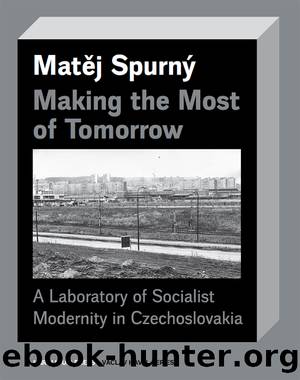Making the Most of Tomorrow by Spurný Matěj;

Author:Spurný, Matěj; [Spurný, Matěj]
Language: eng
Format: epub
Tags: SOC026030 SOCIAL SCIENCE / Sociology / Urban
Publisher: Karolinum Press
Published: 2019-10-14T00:00:00+00:00
In connection with the political milestones of the years 1938 (the Munich Agreement and the Second Republic, 1939 (the beginning of the German occupation followed by the beginning of the Second World War), 1945 (the Liberation), and 1948 (the Communist takeover in February), there is a general tendency to perceive the thinking of the First Republic, from 1918 to 1938, including ideas about the public space, and the reality of the lives of the people living there (for example, the way ZlÃn operated) as something that existed within a closed period. Though ZlÃn was continually developing even during the war (under the supervision of the same architects) and afterwards, including after the Communist takeover (without the better-known architects, yet to a large extent based on their plans for many years after), this is even more true of the ideas of the interwar avant-garde. Teige, stigmatized by the new power-holders as too radical a modernist and an alleged âTrotskyistâ, was silenced after the Communist takeover and died soon afterwards, yet figures like HonzÃk, Fragner, VoženÃlek, Janů, and Å tursa shaped the debate about architecture and space, mainly urban space, in the 1950s and often well into the 1960s. It was largely the avant-garde architects of interwar Czechoslovakia who created the intellectual environment in which the vision of the new Most was born in the late 1950s and early 1960s.
Yet, after 1948, the post-war debate about architecture, urban planning, and the new towns developed in Czechoslovakia, paradoxically, with a number of detours and returns. The period of social revolution and the building of socialism, from the standpoint of a number of modernists, was seen as the gateway to making their dreams and visions come true. In its first phase, the period was marked mainly by a return to tradition.
Criticism of Functionalism and Constructivism, conforming to the Soviet environment, which during the 1930s returned to Revivalist architecture, could to some extent follow on from the interwar left-wing architectsâ departure from the formalism of modern Corbusierian architecture (which, according to them, had failed to solve the essence of the problem, that is, the lack of decent housing for the poor). âPurism, Constructivism, and Functionalism,â wrote HonzÃk in the mid-1950s, âwere not based on a clear Weltanschauung [â¦], the connection with the Weltanschauung of Marxism-Leninism was tenuous, and if it at first seemed to exist, it became increasingly clear that the trends suited capitalism [â¦].â329 HonzÃk would also follow on from his criticism of his own ideas in the interwar years, in which he distanced himself from the modernist dislike of ornament;330 in the 1950s, he did not scruple to call the rejection of ornament âpurist dogmaâ from which architecture should now distance itself, just as it should now also distance itself from the anti-traditionalism promoted by the Functionalists and Constructivists.331 The traditional, Revivalist use of elements on façades was, however, defended by HonzÃk and other architects, mainly with regard to the ageing of buildings, though arguments were made about ânational folk artâ as a fundamental source of inspiration.
Download
This site does not store any files on its server. We only index and link to content provided by other sites. Please contact the content providers to delete copyright contents if any and email us, we'll remove relevant links or contents immediately.
The Vikings: Conquering England, France, and Ireland by Wernick Robert(79221)
Ali Pasha, Lion of Ioannina by Eugenia Russell & Eugenia Russell(39938)
The Vikings: Discoverers of a New World by Wernick Robert(36830)
The Conquerors (The Winning of America Series Book 3) by Eckert Allan W(36715)
Cecilia; Or, Memoirs of an Heiress — Volume 1 by Fanny Burney(32091)
Cecilia; Or, Memoirs of an Heiress — Volume 3 by Fanny Burney(31481)
Cecilia; Or, Memoirs of an Heiress — Volume 2 by Fanny Burney(31435)
Empire of the Sikhs by Patwant Singh(22779)
Hans Sturm: A Soldier's Odyssey on the Eastern Front by Gordon Williamson(18341)
The Secret History by Donna Tartt(18266)
Cat's cradle by Kurt Vonnegut(14804)
Sapiens: A Brief History of Humankind by Yuval Noah Harari(14006)
Pimp by Iceberg Slim(13828)
Talking to Strangers by Malcolm Gladwell(12916)
Norse Mythology by Gaiman Neil(12879)
Leonardo da Vinci by Walter Isaacson(12833)
Underground: A Human History of the Worlds Beneath Our Feet by Will Hunt(11857)
4 3 2 1: A Novel by Paul Auster(11842)
The Radium Girls by Kate Moore(11651)
